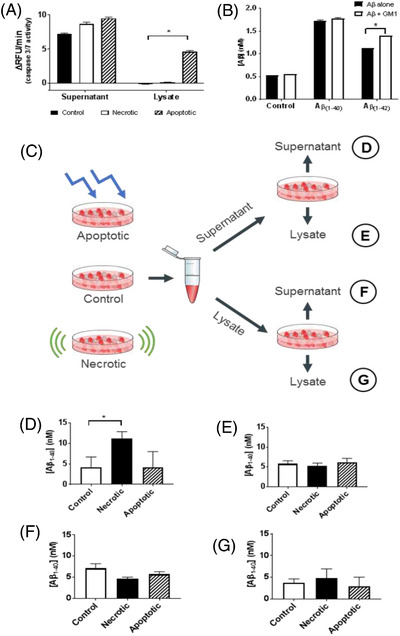FIGURE 4.

Amyloid beta (Aβ) production in response to innate immune activation. (A) To specify the signaling leading to upregulation of Aβ production, cells were treated with mechanical agitation (scraping) to induce necrosis and ultraviolet light (10 minutes with 254 nm light) to induce apoptosis. Evaluation of caspase‐3/7 activity, by relative fluorescence per minute (ΔRFU/min), verified which treatments led to a specified mode of cell death, with only the apoptosis treatment significantly elevating caspase activity (P < 0.01, in lysate). (B) Aβ production in response to incubation with fluorescently labeled Aβ (10 μM), and GM1 (molecular marker of neural necrosis, 5 μM). Significant elevation in Aβ production followed exposure to Aβ1‐40. Aβ1‐42 induces less Aβ production, though addition of GM1 significantly elevates Aβ levels (P > 0.01)—indicating synergy between neural necrosis and self‐perpetuated release of Aβ. (C) Scheme to quantify origin of elevated Aβ signaling, exposing control/necrotic/apoptotic cells’ supernatant and lysates to fresh SK‐N‐AS cells, with subsequent quantification of Aβ production in supernatant and lysates. (D) Aβ production in supernatant of cells exposed to supernatant of noxious cells; necrotic supernatant significantly (P = 0.03) elevated Aβ production. E, Aβ production in lysates of cells exposed to supernatant of noxious cells; no significant difference. (F) Aβ production in supernatants of cells exposed to noxious lysates; no significant difference. (G) Aβ production in lysates of cells exposed to noxious lysates; no significant difference
